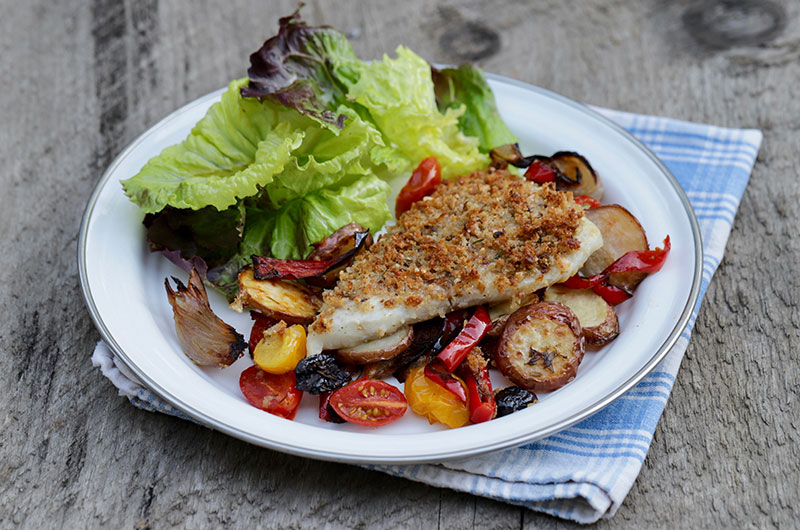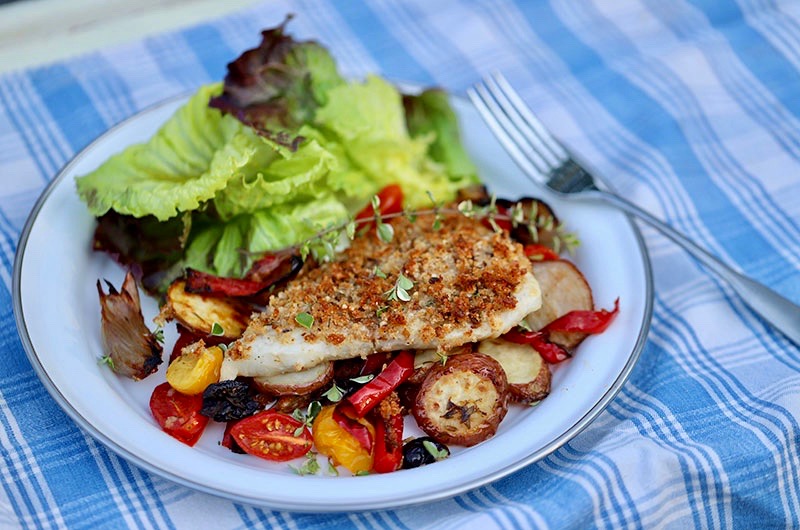All fluke are flounder. All flounder are not fluke. Fluke, around here, is also called Vineyard sole, but it’s not really sole. Technically, fluke is summer flounder (as opposed to winter flounder). And sole is not actually in the same family as flounder — though they are both flat fish, both bottom feeders.
Got that? Good, I don’t.
I just know that I had a rush of nostalgia for flounder the other day. And fluke presented itself. Of course I was at The Net Result for something else, but I came home with “Fluke: aka Vineyard sole.”
In the coastal town in Delaware where I spent my summers — a town wedged between cornfields and peach orchards on one side and the clam and blue crab-studded Delaware Bay on the other — we ate flounder. Lots of flounder.
I have no idea what kind of flounder, it was just the fish my uncles caught, sometimes from the boat, sometimes from shore, but usually close to the jetty or the breakwater where those sneaky flounder liked to hang out. I swear they also hid their wily wide bodies under the soft sand of the sandbar that we’d swim out to every afternoon. As if the jellyfish and the pinching crabs weren’t bad enough, occasionally you’d step on something that moved. Yikes. This is why we manned our raft like a lifeboat.
No matter where the flounder was caught, it wound up back at the marina under the knife. I can still see the green-headed horseflies buzzing around the bucket of fish heads, I can smell that tinny stench of fish blood, see it dripping off the big white porcelain sink on the dock, hear the sputter of the hose and the rush of water spraying everything down at the end in the blazing late afternoon low-slung sun.
At dinnertime, we set the table on the screened-in porch, our hands sometimes splotched purple from picking beach plums. The cottage was downwind of the clam factory, a comfortably familiar smell. A cacophonous orchestra of crickets accompanied every meal.
And we ate our flounder, pan-fried. That is, lightly dredged in flour and cooked in butter until everything was nicely browned (the fish and the butter). The smallest pieces of flounder got crispy. I liked those best. I don’t remember such a thing as a lemon hanging around.
With this flounder we had Silver Queen corn that we got that afternoon out at Nassau orchard market, straight off the truck coming in from the field. Sometimes we ate it on the cob with the little yellow plastic corn holders jabbed into the ends of the cobs. We used dinner knives to politely anoint the corn with salted butter. And sometimes we ate the corn cut off the cob, simmered with pole lima beans, heavy cream, more butter, salt and lots of pepper. Delmarva succotash. (None of us have heart disease, amazingly.)
Also, tomatoes were always on the table. Big beefsteak tomatoes, sliced. No olive oil, no basil, no fresh mozzarella. Just salt and pepper. When we didn’t eat the tomatoes raw, we had them fried — but not Southern style. They weren’t green and there wasn’t a speck of cornmeal in sight. They were sliced thickly, salt and peppered, dredged in more flour (Wondra, I think) and fried in, not butter, but bacon fat. The flavor of the tomato intensified, and it wasn’t a flavor I particularly liked as a child. But my father had grown up eating those fried tomatoes, so my mother made them. Something stuck though; later I became obsessed with the flavor of roasted, caramelized tomatoes.
Most nights there were also pole green beans, sometimes from Lloyd’s IGA, sometimes from a small sandy plot of vegetables my father had planted.
We ate this meal over and over again. Afterwards, a trip to the Dairy Queen up at the other end of the beach, or a trip into town to King’s ice cream.
I tell you all this only to illustrate how hard-wired I am to pan-fry flounder. Which is why when I got my fluke home, I struggled to cook it some other way, to offer you a useful recipe that might go beyond flour, butter and lemon.
I wanted to do this, because fluke — summer flounder, Vineyard sole — is here, coming off the boats in Menemsha every day, making a quick trip to our seafood markets. You may be catching it yourself. It’s a summer treat. It’s quick-cooking. And it’s tasty — bottom feeding fish tend to snatch up tiny crabs and other delicacies that lend them flavor.
At last I decided I would try the fluke in a variation of a recipe I’ve done for parmesan-crumb-coated cod roasted with a lot of veggies. The veggies roast first; the fish joins them at the end. But for the thin flounder, I switched from a baking dish to a sheet pan. You know, the all-in-one-sheetpan dinner for two.
Honestly, this recipe is tasty and a great way to use little potatoes and other goodies from the market. But you must be vigilant once you lay the fish on the sheet pan and return it to the oven. The filets will be cooked through in 8 to 10 minutes.
And I’d say if you only have fluke once this summer, you should pan-fry it. Cut the filets in half to make them easier to handle. Cook until golden brown on one side, flip and cook just a minute or two more. Take them out of the pan, throw in a little more butter and some lemon juice, swirl and drizzle on the fish.
Goes great with steamed spinach — or fried (red) tomatoes.
Susie Middleton's Off the Menu column is printed in the Vineyard Gazette every Friday.




 1 comment
1 comment



Comments (1)